August 25, 2008 8:22 AM CDT
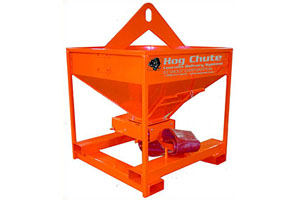
New mixers, pumps and delivery systems are answering masonry contractors' call for equipment that can perform well on the jobsite, withstand vigorous use and reduce labor costs. Equipment introduced to the market within the last year has been built tough, while requiring fewer operators.
"Mixers today are being built to last years instead of months," says Damian Lang, president of EZ Grout Corp. in Waterford, Ohio. "Until a few years ago, mason contractors considered most mixers to be throw-away mixers, while only planning for a year or two of use out of their purchases. Today, the trend is moving toward investing in a quality mixer upfront that will last for years and will not break down during use."
Langs says most contractors realize that a breakdown is more costly than spending a little extra money to buy higher quality equipment in the first place.
"Only 30 percent of the cost of a piece of equipment is incurred the day it is purchased," he says. "The other 70 percent is incurred during use. Therefore, buying on price alone is a losing proposition. A contractor can save money the day he buys the piece of equipment or every day he uses it. Most would rather be paid back daily, after the purchase has been made."
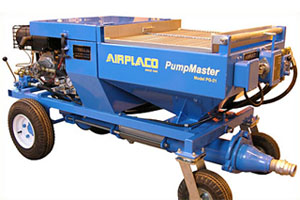
"The Airplaco PG-21 provides an option for block fill contractors," says Tom Norman, Airplaco product manager. "It saves a lot of labor and equipment that is needed in traditional methods of filling block."
Capable of pumping aggregate up to 50 feet vertically or 125 feet horizontally, the pump can deliver 210 cubic feet per hour, says Todd Ferguson, marketing manager for the company. The pump, powered by a 20-horsepower diesel engine, does not need to be elevated.
"It really provides a better solution and better option over more traditional methods of block filling, and all of the equipment and labor that's needed to do that," Ferguson says. "There is a price benefit. Others have to have a mixer and a forklift, and that adds up after a while."
As buildings get taller and extend beyond the reach of telehandlers, Ferguson says he expects the market to lean toward pumps that can operate independently. "I see more people going toward equipment that doesn't have the inconvenience of a having to have a forklift onsite," he says.
Delivery systems are also making advances. Lang says EZ Grout just launched a new version of its popular Up Hill Grout Hog that dispenses grout 50 percent faster. In addition, the company released a new concrete delivery system called the Hog Chute.
"The advantage of the Hog Chute is that, unlike other concrete dump buckets on the market, you can easily and quickly pour large volumes of concrete while maintaining control of the concrete at the point of discharge," he says.
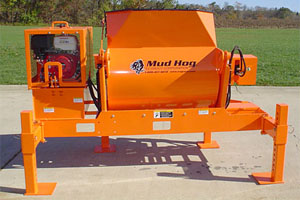
"In 2008, we came out with a flat, self-cleaning frame on the Mud Hog mixers that does not collect the access mortar and grout constantly being spilled while mixing," he says. "This feature avoids mortar or grout getting into hydraulic lines and other fittings that could later cause a breakdown."
Cylinders in the Mud Hog lift the material, instead of the laborer having to do the extra lifting. The mixer comes standard with an electric start, so the masonry contractor's job doesn't stop if the pull cord breaks. This year, the company changed the rubber material used in its blades, and built the drum out of heavy steel.
"Fork pockets are put on both ends and the front and back, so [the mixer] can be lifted with a forklift at any angle," Lang says. "We do not have wheels that are in the way of dumping into a mud pan or a wheel barrow."
Since the Mud Hog will mix up to 3/4-inch of aggregate, it can be used to mix mortar or grout, he says. The hydraulic mixers never shut down due to plugging, because unplugging is as simple as moving a handle to reverse the rotation of the paddles. The mixer design also allows users to more easily load materials.
"With the cylinders on our Mud Hogs doing the higher lifting, the laborer loads the materials at a much lower height than conventional mixers, while the machine lifts and dumps into a high mud pan or even right into a Grout Hog," Lang says.
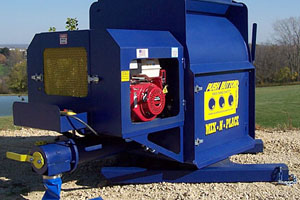
Another new mixer, the Mix-N-Place by Push Button Masonry in Sherrill, Iowa, was unveiled in April 2007. It is designed to mix and place mortar and grout with a single machine, says Rick Cummer, who co-owns the company with his brother, Tom.
"You save on equipment costs and reduce forklift time, because you do the mixing and placing with one machine," Cummer says. "You never take your mortar board off your wall."
Powered by a 13-horsepower engine, the hydraulic mixer allows masons to handle their grouting with just two people. One person runs the forklift, while the second person controls the equipment. The mixer is brought to the tubs, instead of laborers bringing their tubs to the mixing site, which saves time.
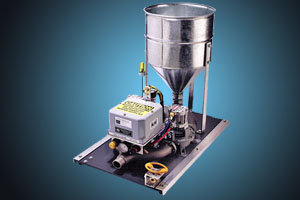
"An automatic dump is so much easier on the user," says David Birmingham Jr., president of Macalite, which manufactures the Hydra-Flow mixer. "It results in fewer injuries by making it easier on the person using the equipment. You just flip a lever, and it will rotate and dump the load."
The mixers, which will hold 13 or 16 cubic feet of mortar, will be modeled after the company's current hydraulic mixers that mount on trucks, trailers, wheels or skids. The mixers don't have a gearbox, drive belt or clutch for a simpler operation, and there is a forward and reverse for dispensing mortar.
Within the next three to five years, Birmingham expects to see a continued trend of equipment that's user friendly. "We're trying to make equipment easier on the operator and make equipment that lasts longer and is more reliable," he says.
One obstacle that will present a challenge to manufacturers is the rising price of steel, which could result in rising equipment prices.
"The price of steel and manufacturing parts keeps getting higher and higher, so some of these costs will have to be passed on from the manufacturers to the end users," Lang says. "However, like in any other industry, manufacturers of this equipment will have to learn to produce their equipment quicker and with better technology at the factory, while still maintaining the same quality in order to compete with lower labor markets that will keep the price of mixers close to where they are now over the next three to five years."
Mixers, Pumps and Delivery Systems
Innovative designs reduce labor and save masons money
By Brett Martin

The Hog Chute can easily and quickly pour large volumes of concrete while maintaining control of the concrete at the point of discharge. Image Courtesy of EZ Grout.
"Mixers today are being built to last years instead of months," says Damian Lang, president of EZ Grout Corp. in Waterford, Ohio. "Until a few years ago, mason contractors considered most mixers to be throw-away mixers, while only planning for a year or two of use out of their purchases. Today, the trend is moving toward investing in a quality mixer upfront that will last for years and will not break down during use."
Langs says most contractors realize that a breakdown is more costly than spending a little extra money to buy higher quality equipment in the first place.
"Only 30 percent of the cost of a piece of equipment is incurred the day it is purchased," he says. "The other 70 percent is incurred during use. Therefore, buying on price alone is a losing proposition. A contractor can save money the day he buys the piece of equipment or every day he uses it. Most would rather be paid back daily, after the purchase has been made."

The Airplaco PG-21 saves a lot of labor and equipment that is needed in traditional methods of filling block. Image Courtesy of Airplaco Equipment.
Money-saving Pumps and Delivery Systems
Earlier this year, Airplaco Equipment Co. in Cincinnati brought its PumpMaster model PG-21 to the market. Designed for masonry block fill applications, the grout pump is able to fill blocks without a telehandler or a full-size concrete pump."The Airplaco PG-21 provides an option for block fill contractors," says Tom Norman, Airplaco product manager. "It saves a lot of labor and equipment that is needed in traditional methods of filling block."
Capable of pumping aggregate up to 50 feet vertically or 125 feet horizontally, the pump can deliver 210 cubic feet per hour, says Todd Ferguson, marketing manager for the company. The pump, powered by a 20-horsepower diesel engine, does not need to be elevated.
"It really provides a better solution and better option over more traditional methods of block filling, and all of the equipment and labor that's needed to do that," Ferguson says. "There is a price benefit. Others have to have a mixer and a forklift, and that adds up after a while."
As buildings get taller and extend beyond the reach of telehandlers, Ferguson says he expects the market to lean toward pumps that can operate independently. "I see more people going toward equipment that doesn't have the inconvenience of a having to have a forklift onsite," he says.
Delivery systems are also making advances. Lang says EZ Grout just launched a new version of its popular Up Hill Grout Hog that dispenses grout 50 percent faster. In addition, the company released a new concrete delivery system called the Hog Chute.
"The advantage of the Hog Chute is that, unlike other concrete dump buckets on the market, you can easily and quickly pour large volumes of concrete while maintaining control of the concrete at the point of discharge," he says.

Cylinders in the Mud Hog lift the material, instead of the laborer having to do the extra lifting. Image Courtesy of EZ Grout.
Better-designed Mixing Systems
New mixers are being made to last longer, eliminate breakdowns and reduce user fatigue. Lang says EZ Grout improved the frame on its Mud Hog mixers to make them more resistant to problems caused by spills."In 2008, we came out with a flat, self-cleaning frame on the Mud Hog mixers that does not collect the access mortar and grout constantly being spilled while mixing," he says. "This feature avoids mortar or grout getting into hydraulic lines and other fittings that could later cause a breakdown."
Cylinders in the Mud Hog lift the material, instead of the laborer having to do the extra lifting. The mixer comes standard with an electric start, so the masonry contractor's job doesn't stop if the pull cord breaks. This year, the company changed the rubber material used in its blades, and built the drum out of heavy steel.
"Fork pockets are put on both ends and the front and back, so [the mixer] can be lifted with a forklift at any angle," Lang says. "We do not have wheels that are in the way of dumping into a mud pan or a wheel barrow."
Since the Mud Hog will mix up to 3/4-inch of aggregate, it can be used to mix mortar or grout, he says. The hydraulic mixers never shut down due to plugging, because unplugging is as simple as moving a handle to reverse the rotation of the paddles. The mixer design also allows users to more easily load materials.
"With the cylinders on our Mud Hogs doing the higher lifting, the laborer loads the materials at a much lower height than conventional mixers, while the machine lifts and dumps into a high mud pan or even right into a Grout Hog," Lang says.

The Mix-N-Place by Push Button Masonry is designed to mix and place mortar and grout with a single machine. Image Courtesy of Push Buttom Masonry.
"You save on equipment costs and reduce forklift time, because you do the mixing and placing with one machine," Cummer says. "You never take your mortar board off your wall."
Powered by a 13-horsepower engine, the hydraulic mixer allows masons to handle their grouting with just two people. One person runs the forklift, while the second person controls the equipment. The mixer is brought to the tubs, instead of laborers bringing their tubs to the mixing site, which saves time.

The GP-6 Grout Pump from Kenrich Products Inc. offers a solution for pumping at low pressure. Image Courtesy of Kenrich Products.
Coming Next
Masonry contractors can look forward to new equipment later this year, including a hydraulic mixer that can automatically dump its load from Hydra-Flow Mortar Mixers in Phoenix."An automatic dump is so much easier on the user," says David Birmingham Jr., president of Macalite, which manufactures the Hydra-Flow mixer. "It results in fewer injuries by making it easier on the person using the equipment. You just flip a lever, and it will rotate and dump the load."
The mixers, which will hold 13 or 16 cubic feet of mortar, will be modeled after the company's current hydraulic mixers that mount on trucks, trailers, wheels or skids. The mixers don't have a gearbox, drive belt or clutch for a simpler operation, and there is a forward and reverse for dispensing mortar.
Within the next three to five years, Birmingham expects to see a continued trend of equipment that's user friendly. "We're trying to make equipment easier on the operator and make equipment that lasts longer and is more reliable," he says.
One obstacle that will present a challenge to manufacturers is the rising price of steel, which could result in rising equipment prices.
"The price of steel and manufacturing parts keeps getting higher and higher, so some of these costs will have to be passed on from the manufacturers to the end users," Lang says. "However, like in any other industry, manufacturers of this equipment will have to learn to produce their equipment quicker and with better technology at the factory, while still maintaining the same quality in order to compete with lower labor markets that will keep the price of mixers close to where they are now over the next three to five years."
About the Author
Brett Martin is a freelance writer located in Shakopee, Minn. with several years of construction and writing experience.


















